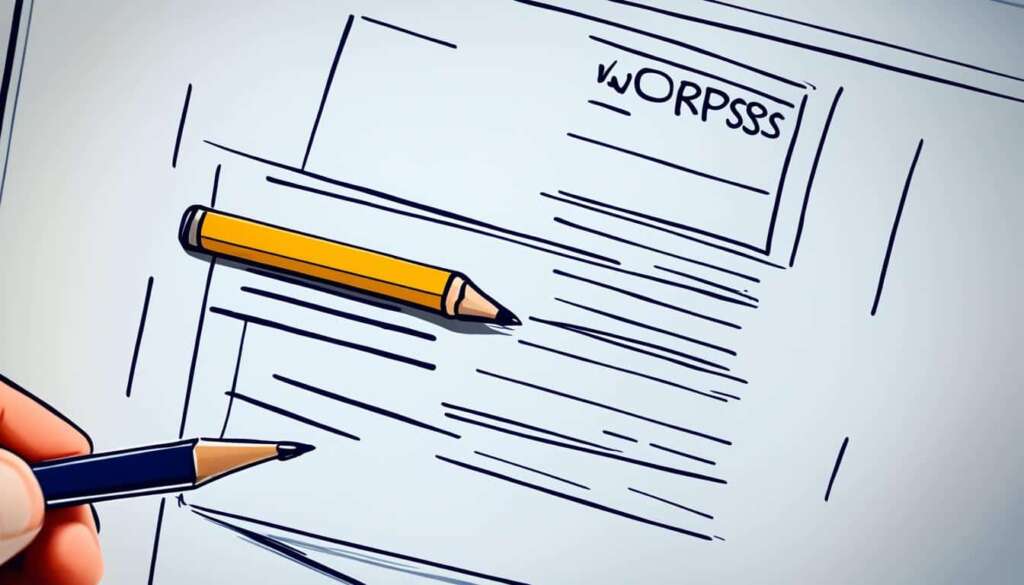Table of Contents
Welcome to our comprehensive guide on editing menus in WordPress. Whether you’re a beginner or an experienced user, mastering the art of editing menus is essential for enhancing your website’s navigation and creating an optimal user experience. In this guide, we’ll take you through the step-by-step process, providing you with valuable techniques to make your WordPress menus stand out.
Key Takeaways
- Understanding the importance of WordPress menus in improving website navigation.
- Learning how to access the menu editor in the WordPress dashboard.
- Adding, removing, and rearranging menu items to create a customized menu structure.
- Exploring various options for customizing menu appearance and styling.
- Implementing strategies to optimize your website’s navigation and enhance user experience.
Understanding WordPress Menus and their Importance
Before we delve into the editing process, let’s take a moment to understand the significance of WordPress menus in website navigation. WordPress menus are an essential component of any website, allowing visitors to navigate and explore the various sections and pages effortlessly.
WordPress menus are primarily composed of two key elements: menu items and menu locations. Menu items refer to the individual links that appear in the menu, directing users to different parts of the website. Menu locations, on the other hand, define where the menu will be displayed within a theme.
The importance of WordPress menus cannot be overstated. They serve as a roadmap for visitors, guiding them through the different sections and helping them find the information they seek. Well-structured and intuitive menus enhance user experience, reduce bounce rate, and encourage visitors to explore more of your website’s content.
Key Benefits of Well-Designed WordPress Menus
- User-Friendly Navigation: An organized and intuitive menu helps users easily locate the information they need without frustration.
- Improved Engagement: Clear and well-structured menus increase visitors’ engagement by encouraging them to explore more of your website.
- Enhanced Accessibility: Thoughtfully designed menus make your website more accessible to all users, ensuring that important content is easily discoverable.
- Responsive Design: With mobile browsing becoming increasingly prevalent, responsive menus adapt seamlessly to different screen sizes, providing a consistent user experience.
- SEO Benefits: Well-optimized menus contribute to better search engine visibility, as search engines consider website navigation when ranking pages.
Understanding the importance of WordPress menus is crucial for creating an effective website. By implementing user-friendly navigation and thoughtful menu design, you can ensure a positive browsing experience for your visitors and maximize the impact of your website’s content.
Accessing the Menu Editor in WordPress
When it comes to editing menus in WordPress, accessing the menu editor is the first step. This section will walk you through the process, ensuring you can effortlessly locate the menu editor within the WordPress dashboard.
To access the menu editor, follow the steps below:
- Login to your WordPress admin dashboard.
- From the sidebar, hover over the “Appearance” tab.
- A submenu will appear. Click on “Menus”.
By following these simple steps, you will be directed to the menu editor interface, where you can make all the necessary changes and enhancements to your menus.
Once you access the menu editor, you will be greeted with a user-friendly interface that allows you to manage your menus efficiently. Let’s take a closer look at the various options available to you:
- Menu Structure: This section displays the current structure of your menu, including the hierarchy of menu items.
- Add Menu Items: You can use this option to add new menu items to your menu. Whether it’s pages, posts, custom links, or even categories, you have the flexibility to include a wide range of content.
- Manage Locations: This feature allows you to assign different menus to specific locations on your website. For example, you can designate a menu to appear in the header, footer, or sidebar, depending on your theme.
- Menu Settings: Here, you can customize the display options for your menu. You can choose the menu container, toggle on or off a search form, and add a CSS class to style your menu further.
To give you a better idea of the menu editor interface, here’s a visual representation:
| Menu Editor Interface | Description |
|---|---|
| The menu editor interface in WordPress showcases the menu structure, menu items, and customization options that you can utilize to edit your menus effectively. |
Now that you have successfully accessed the menu editor in WordPress and familiarized yourself with its interface and options, you are ready to dive into editing menus, as we will explore in the following sections.
Adding, Removing, and Rearranging Menu Items
One of the primary tasks in editing menus is managing menu items. By adding, removing, and rearranging menu items, you can create a well-structured and user-friendly navigation menu tailored to your website’s needs.
Adding Menu Items
Adding new menu items to your WordPress menu is a simple process. Follow these steps:
- Go to the menu editor in your WordPress dashboard.
- Locate the menu to which you want to add a new item.
- Choose the desired menu item type from the available options, such as pages, posts, custom links, or categories.
- Select the specific items you want to add to the menu.
- Click the “Add to Menu” button to add the selected items to your menu.
Once added, the new menu items will be visible in your menu structure. You can then further customize their label, order, and other attributes as needed.
Removing Menu Items
If you no longer want a specific menu item to appear in your navigation menu, follow these steps to remove it:
- Navigate to the menu editor in your WordPress dashboard.
- Locate the menu that contains the item you want to remove.
- Expand the menu item section to reveal its settings.
- Click the “Remove” or “Delete” button associated with the item you wish to remove.
The selected menu item will be removed from your menu structure, and it will no longer appear in your navigation menu.
Rearranging Menu Items
Rearranging menu items allows you to change the order in which they appear in your navigation menu. To rearrange menu items, follow these steps:
- Access the menu editor in your WordPress dashboard.
- Locate the menu containing the items you want to rearrange.
- Drag and drop the menu items to the desired position within the menu structure.
By dragging and dropping the items, you can rearrange them according to your preferred order. The changes will be reflected in your navigation menu immediately.
By mastering the art of adding, removing, and rearranging menu items, you have gained the skills to customize your website’s navigation with ease. Let’s move on to the next section and explore how to customize the appearance and styling of your menus.

Customizing Menu Appearance and Styling
Beyond the structure and content of menus, their appearance and styling can significantly impact the overall aesthetics of your website. By customizing the menu appearance and styling, you can create visually appealing and user-friendly menus that align with your website’s design.
Here are some key customization options to consider:
1. Changing Menu Colors
One way to customize the menu appearance is by changing the colors. You can choose colors that match your website’s branding or create a visually contrasting effect. Use CSS to modify the background color, text color, hover effects, and other elements of your menu.
2. Font Styles
Another aspect of menu customization is font styles. You can experiment with different font families, sizes, weights, and styles to achieve the desired look. Consider using web-safe fonts or integrating custom fonts using Google Fonts or other font services.
3. Adding Icons
Icons can enhance the visual appeal of your menus and make them more intuitive. Use icon libraries like Font Awesome or create custom icons to represent menu items. Icons can be placed alongside text or used as standalone representations of menu items.
4. Implementing Dropdown Menus
Dropdown menus provide a hierarchical structure to your navigation, allowing you to group related menu items and enhance user experience. With HTML and CSS, you can create dropdown menus that appear when users hover or click on specific menu items, providing additional navigation options.
Did you know? Customizing the appearance and styling of your menus goes beyond aesthetics. By creating visually appealing menus, you can improve user engagement, increase navigation efficiency, and convey a professional and consistent brand image.
By customizing the menu appearance and styling, you can create a unique and cohesive website that reflects your brand identity. Experiment with different customization options, test them on different devices, and gather feedback from users to refine your menu design.
| Customization Option | Description |
|---|---|
| Changing Menu Colors | Modify the background color, text color, hover effects, etc., to create a visually appealing menu. |
| Font Styles | Experiment with different font families, sizes, weights, and styles to achieve the desired look. |
| Adding Icons | Enhance the visual appeal and intuitiveness of your menus by incorporating icons. |
| Implementing Dropdown Menus | Create hierarchical navigation by implementing dropdown menus for grouped menu items. |
Customizing the appearance and styling of your menus allows you to create a unique website that captivates users and provides a seamless navigation experience.
Conclusion
Now that you have explored this simplified guide on editing menus in WordPress, you possess the knowledge and tools necessary to optimize your website’s navigation. Remember, a well-organized and intuitive menu is key to enhancing the user experience and facilitating easy exploration of your website’s content. By implementing the strategies outlined in this guide, you can watch your website’s navigation improve and shine.
As you edit your menus, keep in mind that they are an essential component of your website’s design and functionality. Take advantage of WordPress’s menu editor to add, remove, and rearrange menu items to create a logical and user-friendly structure. Additionally, customize the appearance and style of your menus to align with your website’s branding and aesthetics.
By paying attention to the details of your website’s menus, you are showing your commitment to providing a seamless and enjoyable browsing experience for your visitors. Ensure that your menu is easily accessible and reflects the content hierarchy of your site. Remember to regularly review and update your menus as your website’s content evolves, ensuring that they remain relevant and user-centric.
FAQ
To access the menu editor in WordPress, follow these steps:
1. Log in to your WordPress dashboard.
2. Navigate to the “Appearance” section on the left menu.
3. Click on “Menus” to open the menu editor.
To add new items to your menu in WordPress, perform the following steps:
1. Open the menu editor in the WordPress dashboard.
2. On the left side, select the menu you want to edit or create a new one.
3. On the left menu of the editor, locate the section titled “Add menu items.”
4. Click on the “+” icon to expand the section.
5. Choose the items you want to add from the available options (such as pages, posts, custom links, or categories), and click on “Add to Menu.”
6. Drag and drop the added items to rearrange their order if necessary.
7. Finally, click “Save Menu” to apply the changes to your menu.
Yes, you can remove items from your menu in WordPress by following these steps:
1. Open the menu editor in the WordPress dashboard.
2. Locate the item you want to remove in the list of menu items on the right side of the editor.
3. Expand the menu item by clicking on the arrow next to it.
4. At the bottom of the expanded item, click on the “Remove” link.
5. The item will be removed from the menu immediately.
6. Don’t forget to click on “Save Menu” to save the changes to your menu.
To rearrange the order of menu items in WordPress, follow these steps:
1. Open the menu editor in the WordPress dashboard.
2. On the right side of the editor, locate the menu items you want to rearrange.
3. Click and hold the item you want to move.
4. Drag it to the desired position within the menu.
5. As you drag the item, you will see a blue line indicating where the item will be placed.
6. Release the mouse button to drop the item in its new position.
7. Remember to click on “Save Menu” to apply the changes to your menu.
To customize the appearance of your menu in WordPress, follow these steps:
1. Open the menu editor in the WordPress dashboard.
2. On the left side, select the menu you want to customize.
3. On the right side of the editor, click on the “Expand” button next to the menu item you want to customize.
4. Various customization options will appear, such as changing the menu item’s label, adding a CSS class, or adding a description.
5. Make the desired changes to the menu item.
6. Repeat this process for each menu item you want to customize.
7. Once you’ve made all the desired changes, click on “Save Menu” to save the customized appearance of your menu.












